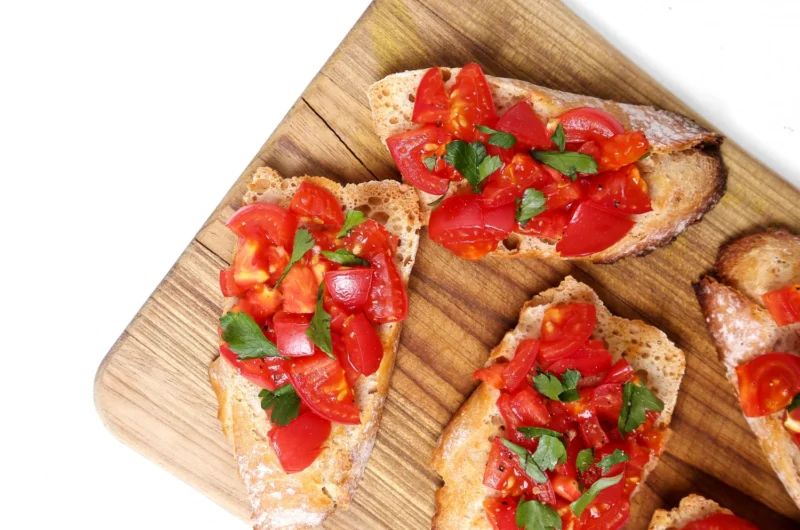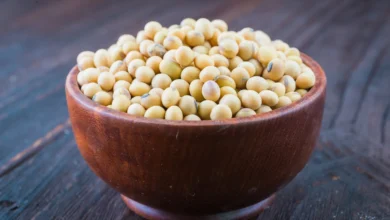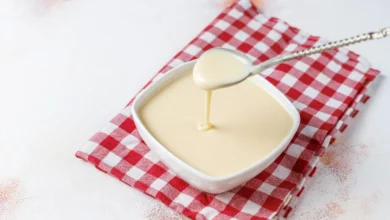Bread for Bruschetta – Recipe for Delicious Bruschetta

Picture this: It’s a warm summer evening, and you’re craving something simple yet oh-so-delicious. Bruschetta to the rescue! This classic Italian appetizer is all about fresh flavors and high-quality ingredients. Crispy toasted bread, juicy tomatoes, fragrant garlic, a whisper of balsamic vinegar… need I say more? It’s the perfect starter at home or a fancy party. Best of all, bruschetta is incredibly easy to make. Let’s start with the heart of it all: the bread!
Contents
- Bread for Bruschetta
- Nutrition Facts (per serving)
- Bread for Bruschetta Recipe
- Ingredients
- Directions
- Notes
- Frequently Asked Questions
- What qualifies as bruschetta?
- Is bruschetta served cold or warm?
- What bread is bruschetta made from?
- What is used in bruschetta?
- What is bruschetta toast called?
- What is the best bread to eat with Italian food?
- Is bruschetta soft or hard?
- Is bruschetta and garlic bread same?
- How do you eat bruschetta bread?
- What tomatoes are best for bruschetta?
Bread for Bruschetta
Now, we will explore different breads and different toppings we can use. We will also learn how to make Bread for Bruschetta.
What is Bruschetta?
Bruschetta (say it like brew-SKET-tah) is a delicious Italian appetizer, or antipasti, that’s as fun to make as it is to eat! Here’s how it works:
- The Base: Slices of bread are toasted or grilled until crispy and golden. It’s best to serve the bread warm for maximum flavor.
- The Topping: This is where you get creative! Tomato mixtures are classic, but bruschetta can be topped with so many amazing things. We’ll talk more about that later.
- How It’s Served: Often, the topping for bruschetta is either spooned over the toasted bread, or placed on the side so each person can build their own. It’s meant to be hand-held finger food, large enough for a delicious bite or two.
Best Bread for Bruschetta
The right bread makes all the difference for a delicious bruschetta! You want a sturdy loaf with a bit of crust and a firm texture that can hold up to the topping without turning soggy. Here are some of the best choices:
- Italian Breads: Ciabatta is a traditional favorite for its light, airy interior and flavorful crust. Other Italian loaves offer similar qualities.
- French Bread: A baguette is a simple but perfect choice. Look for a long, thin loaf and try slicing it on the diagonal. Slices should be about ¼-inch thick for that classic oval shape.
Whichever bread you choose, quality matters! A freshly baked loaf from a bakery or the artisan section of your grocery store will really elevate your bruschetta.
Can You Use Stale Bread for Bruschetta
Absolutely! Bruschetta is actually a great way to avoid wasting bread that’s slightly past its shelf life. If you buy good quality, all-natural bread, which is the best for making bruschetta, it will have a shorter shelf life and need to be used up quickly.
Making bruschetta with slightly stale bread is perfect. The toasting or grilling process revives the texture, giving it that desirable crispness without making it crumbly. Just make sure the bread you use is still a bit tough, not completely hard.
How Do You Make Bruschetta?
Here’s a full step-by-step recipe, focusing on your favorite tips for making delicious bruschetta:
Quality Counts: This simple recipe showcases the flavor of individual ingredients, so the better quality you start with, the more delicious the result. Seek out ripe tomatoes, fresh basil (dried will work in a pinch!), good olive oil, and balsamic vinegar. If you can afford it, hand-grated Parmesan cheese is worth it – it melts better than pre-packaged grated.
Optional Garlic & Tomato Prep
- Garlic: For a subtle hint, cut a peeled clove in half lengthwise and lightly rub the surface of the toasted bread. For a stronger flavor (watch out!), use minced, raw garlic in the tomato mixture.
- Tomatoes: Let the tomato mixture sit for a couple of hours – the flavors will develop more complexity. Because tomatoes release juice as they marinate, remember that if your mixture is too juicy at serving time, use a slotted spoon to lift out the topping. You can still spoon or toss the liquid separately – people love dip extra bread in it!
Assemble Just Before Serving: This will prevent your bread from getting soggy. It’s a great step to take at the last minute so you can serve your bruschetta warm with delicious, crisp bread.


Toppings for Bruschetta
Tomato bruschetta might be the most well-known, but there are so many amazing ways to enjoy this appetizer! Technically, the word “bruschetta” refers to the toasted bread itself, so all those creative toppings are simply delicious extras.
Let’s get your topping tastebuds going! Here are a few ideas:
- Beyond the Classic: Think of it as “Italiana deluxe”! Try a cannellini bean topping with wilted Swiss chard for something hearty. Or, take the classic tomato mix and make it into a simple marinara. For a satisfyingly cheesy alternative, try Italian meat sauce with melted cheese over your bruschetta. Sautéed mushrooms and other veggies offer delightful flavor combinations. Don’t be afraid to experiment with your favorites like goat cheese and even sweet toppings like fruit!
- Dips or Toppings? Anything that would go on top of a delicious crostini can be a bruschetta topping, and this includes your favorite dips! Bruschetta doesn’t always need a classic “topping”. I personally love dipping mine in whipped lemon ricotta cheese for a surprising contrast of sweet and crunchy!
What to Serve with Bruschetta
While bruschetta is a classic Italian appetizer, it can absolutely be part of a satisfying meal! Here are a few ideas, along with suggestions for quick and easy dinners to go with your bruschetta:
Keep it Italian: Pair your bruschetta with simple pasta dishes, grilled meats, or a fresh Caprese salad. For a light meal, choose a side of fresh fruit or a crisp green salad.
Quick & Easy Dinner Pairings: Here are some delicious dinner ideas you can whip up in roughly 45 minutes:
- Sausage, Peppers, & Onions: A flavorful and versatile dish that goes beautifully with bruschetta.
- Shrimp Scampi: Serve this over pasta for a light and elegant meal.
- Crispy Baked Chicken: A crowd-pleaser that won’t take up too much kitchen time.
- Giardiniera: Enjoy with bruschetta as a fun, mix-and-match appetizer spread.
All Recipes Community Tips and Praise
It sounds like bruschetta is a popular choice for parties! One reader shared how she made it for a bridal shower, and it was a huge hit. Many bruschetta fans recommend making the tomato mix in advance and toasting the bread right before serving. Serving the cold mix on warm bread was a detail that guests appreciated.
Another reader named MELSY offered some delicious variations she prepared the day before, serving her bruschetta on whole wheat baguette slices brushed with olive oil and garlic. Extra basil added a burst of flavor, and she even topped some slices with fresh mozzarella cheese for an extra-special touch.
Other readers, like blue-eyed CC, chimed in with their own favorites. Adding some chopped red onion is a simple way to enhance the flavor, and many believe that quality canned tomatoes, like diced tomatoes or Romas, make a perfectly tasty and convenient topping option.
Nutrition Facts (per serving)
| Nutrient | Amount |
| Calories | 197 |
| Fat | 4g |
| Carbs | 33g |
| Protein | 8g |
Bread for Bruschetta Recipe
Course: Kitchen BasicsCuisine: Italian6-8
servings15
minutes10
minutes197
kcal25
minutesHere is the recipe ingredients, and instructions. You can also print the recipe for your ease.
Ingredients
1 loaf French baguette, sliced thinly (about ¼-inch)
1 tablespoon olive oil (for brushing bread)
8 Roma tomatoes, chopped
⅓ cup fresh basil leaves, chopped
1 ounce Parmesan cheese, grated
2 garlic cloves, minced
1 tablespoon balsamic vinegar
2 teaspoons olive oil (for the topping)
¼ teaspoon salt
¼ teaspoon black pepper
Directions
- Gather your ingredients: Get everything ready to make assembly quick and easy.
- Preheat oven: Set your oven to 400 degrees F (200 degrees C).
- Prep the bread: Lightly brush both sides of your bread slices with 1 tablespoon of olive oil. Place the slices on a large baking sheet.
- Toast until golden: Bake in the preheated oven for 5–10 minutes, turning halfway through for even browning.
- Mix the topping: While the bread toasts, combine tomatoes, basil, Parmesan cheese, and garlic in a bowl.
- Add flavor: Mix in balsamic vinegar, 2 teaspoons of olive oil, kosher salt, and pepper.
- Assemble: Spoon the tomato mixture onto the toasted bread slices.
- Serve & Enjoy! For the perfect bite, serve while still warm.
Notes
- Quality Matters: For the tastiest bruschetta experience, seek out fresh ingredients and a good-quality loaf of bread.
- Don’t Waste Stale Bread: Have slightly stale bread on hand? Bruschetta is the perfect way to use it up and avoid waste.
- Be Creative: Don’t be afraid to experiment with different toppings! Bruschetta is a delicious way to explore new flavors.
RELATED: Banana Bread with Pear
RELATED: Can You Freeze Sourdough Bread
Conclusion
Choosing the right bread is the foundation of delicious bruschetta. Look for high-quality loaves with a sturdy crust and flavorful interior – ciabatta, sourdough, or a classic baguette are all excellent options. Remember, slightly stale bread can be revived on the grill or in the oven, making bruschetta a wonderful way to avoid food waste. With a crispy base and fresh toppings, you’ll create an appetizer that’s simply irresistible!
___________________________________
Frequently Asked Questions
What qualifies as bruschetta?
At its core, bruschetta is good quality thick-sliced bread that’s been toasted or grilled and drizzled with olive oil. Beyond that,
Is bruschetta served cold or warm?
Bruschetta is best served warm or at room temperature. It should be made shortly before you’re ready to eat it for the ideal texture and flavor.
What bread is bruschetta made from?
The best bread for bruschetta is any sort of sturdy, crusty bread that’s thick enough to hold up to toppings. Italian loaves like ciabatta, or a French baguette are ideal. It’s often sliced on the diagonal to give you plenty of surface area for those tasty tomatoes!
What is used in bruschetta?
The best bruschetta starts with fresh, ripe tomatoes and good quality olive oil. For a basic mix, add a clove of chopped garlic, salt to taste, and a teaspoon or so of balsamic vinegar. Stir in fresh chopped basil just before serving.
What is bruschetta toast called?
While the term “bruschetta” is sometimes used interchangeably with “crostini”, there’s a slight difference. Bruschetta refers to the untopped toasted bread, while the Tuscan dish “fettunta” means something like “oiled slice” and is typically served with toppings.
What is the best bread to eat with Italian food?
Ciabatta is a popular choice! Its origins remain a bit unclear, but the unique structure – a porous center and crispy crust – make it the perfect partner for classic Italian dishes involving lots of sauce. Other fantastic options include rustic flatbreads or even the white, slipper-shaped bread common in Southern Italy.
Is bruschetta soft or hard?
Bruschetta should have a satisfying bite! The bread should feel crunchy on the outside and slightly soft on the inside. You also get the burst of flavor from garlic, the freshness, and sweetness of tomatoes, and the richness of good extra virgin olive oil.
Is bruschetta and garlic bread same?
No. Garlic bread is typically an Italo-American alteration of the traditional Italian bruschetta. Garlic bread uses bread with butter or oil heavily infused with garlic and optionally other herbs and spices.
How do you eat bruschetta bread?
Once the bread has cooled slightly, you can gently rub the slices with the cut side of a garlic clove for added flavor. Then, drizzle lightly with olive oil, top with the bruschetta spread of your choice, a sprinkle of shredded Parmesan cheese, and you’re ready to enjoy!
What tomatoes are best for bruschetta?
Look for sweet, juicy tomatoes in season. Heirloom tomatoes, vine tomatoes, or Roma tomatoes make wonderful bruschetta. I do recommend avoiding grape or cherry tomatoes as they tend to be too watery.





